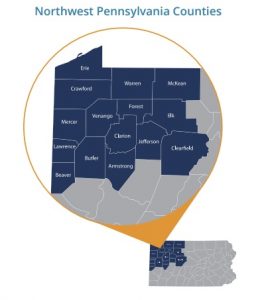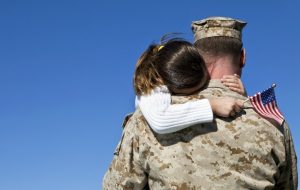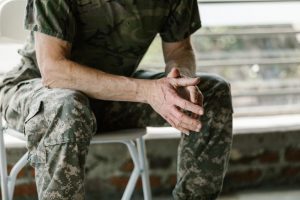Person First: Out of the Darkness, into Life: Why I Walk
 The Northwest Pennsylvania (NW PA) Veteran Suicide Prevention Program operates on a three-pronged approach involving healthcare providers, community organizations, and Veterans and their families in the 15 counties of NW PA. This article marks the start of our “Person-First” series chronicling the lived experiences of Veterans committed to reducing suicide deaths of those who have served in the armed forces.
The Northwest Pennsylvania (NW PA) Veteran Suicide Prevention Program operates on a three-pronged approach involving healthcare providers, community organizations, and Veterans and their families in the 15 counties of NW PA. This article marks the start of our “Person-First” series chronicling the lived experiences of Veterans committed to reducing suicide deaths of those who have served in the armed forces.
Read time: 5 minutes
Please note this article contains graphic wartime details that may not be appropriate for all readers.
Out of the Darkness, into Life: Why I Walk
Mike Felker, U.S. Navy Hospital Corpsman 8/68-8/72
Combat Medic First Marine Division Viet Nam, 12/69-12/70
On October 3rd, I, along with other Veterans, participated in the American Foundation for Suicide Prevention Out of the Darkness Walk. We walked to raise awareness of the impact of suicide among U.S. military Veterans.
- Approximately 22 Veterans commit suicide each day.
- The suicide rate for Veterans is 1.5 times higher than that of the general population.
- Nearly 45 percent of Veterans own guns compared to 20 percent of non-veterans.
- 68 percent of veterans’ suicides are with a firearm.
- Female veterans are more likely than civilian women to use a gun as a method of suicide.
- Between 2005 and 2018, 60,030 veterans died by suicide via firearm.
 As a Navy hospital corpsman, I served as a combat medic with the Marines in the war in Viet Nam, providing emergency medical treatment for our troops injured by landmines or who had been shot. One Marine was shot in the chest while we were on patrol. I put a dressing over the wound, administered artificial resuscitation and CPR, but failed to save him. Other casualties I cared for were Marines who stepped on landmines hidden in the ground. In most cases, the mine would destroy the foot and part of the limb. I would tie a tourniquet around the remains of the leg, wrap a battle dressing over the stump, start an intravenous solution of plasma and give the wounded man a morphine injection. Two other hospital corpsmen and I once performed a tracheotomy to try to save a Marine who had sustained a severe head injury from a tree mine; he died.
As a Navy hospital corpsman, I served as a combat medic with the Marines in the war in Viet Nam, providing emergency medical treatment for our troops injured by landmines or who had been shot. One Marine was shot in the chest while we were on patrol. I put a dressing over the wound, administered artificial resuscitation and CPR, but failed to save him. Other casualties I cared for were Marines who stepped on landmines hidden in the ground. In most cases, the mine would destroy the foot and part of the limb. I would tie a tourniquet around the remains of the leg, wrap a battle dressing over the stump, start an intravenous solution of plasma and give the wounded man a morphine injection. Two other hospital corpsmen and I once performed a tracheotomy to try to save a Marine who had sustained a severe head injury from a tree mine; he died.
 As a young man returning from the war, I was overwhelmed by memories, by guilt; a half-century later, I am still overwhelmed. From my experiences, I understand how difficult it can be for younger Veterans to deal with that despair and heartbreak. It is estimated that up to half of the nearly 3 million Americans who deployed to Iraq or Afghanistan have been diagnosed with a mental health condition. Post-traumatic stress disorder (PTSD) is a mental health condition that can develop when an individual experiences a life-threatening event or severe trauma, like combat. PTSD can include intrusive reminders of the trauma – distressing thoughts, nightmares, flashbacks, and for Veterans, the strongest link to suicide is the disturbing thoughts and extreme guilt related to combat. Veterans with PTSD may withdraw from friends and family, lose interest in everyday activities, or have persistent feelings of fear, guilt, and shame. Importantly, PTSD can manifest at any time following the trauma, from shortly after the trauma to years or decades later.
As a young man returning from the war, I was overwhelmed by memories, by guilt; a half-century later, I am still overwhelmed. From my experiences, I understand how difficult it can be for younger Veterans to deal with that despair and heartbreak. It is estimated that up to half of the nearly 3 million Americans who deployed to Iraq or Afghanistan have been diagnosed with a mental health condition. Post-traumatic stress disorder (PTSD) is a mental health condition that can develop when an individual experiences a life-threatening event or severe trauma, like combat. PTSD can include intrusive reminders of the trauma – distressing thoughts, nightmares, flashbacks, and for Veterans, the strongest link to suicide is the disturbing thoughts and extreme guilt related to combat. Veterans with PTSD may withdraw from friends and family, lose interest in everyday activities, or have persistent feelings of fear, guilt, and shame. Importantly, PTSD can manifest at any time following the trauma, from shortly after the trauma to years or decades later.
 PTSD’s symptoms can be addressed, and there are ways to lessen the threat of Veteran suicide. As Veterans are more likely to own guns than the general population, it is imperative that Veterans be encouraged to treat their personal weapons with the same focus on safety expected of the storage of their military-issued weapon. Notably, the Department of Veterans Affairs provides gun locks to any and every veteran requesting such.
PTSD’s symptoms can be addressed, and there are ways to lessen the threat of Veteran suicide. As Veterans are more likely to own guns than the general population, it is imperative that Veterans be encouraged to treat their personal weapons with the same focus on safety expected of the storage of their military-issued weapon. Notably, the Department of Veterans Affairs provides gun locks to any and every veteran requesting such.
In terms of mental health care, the VA – an arguably over-stressed system due to the sheer volume of need – strives to support Veterans in mental health crises, as do various community agencies. Our responsibility as the families and friends of veterans is to check in with the Veterans we love, engage in meaningful and honest conversations, and encourage them to seek mental health help as appropriate.
As a country committed to sending Veterans into harm’s way, our task is to listen to Veterans’ stories, provide the resources and outreach needed to help Veterans cope with post-traumatic stress, and encourage those in crisis to seek counseling. In addition, we need to increase awareness that suicides can be prevented and increase understanding of the strong links between PTSD, firearms, and suicide.
Resources:
• American Foundation for Suicide Prevention
• U.S. Department of Veterans Affairs National Center for PTSD
• American Addiction Centers/Suicide Among Veterans
Help Us Reduce Veteran Suicide Deaths. Get Involved.
If you are a Veteran working to reduce suicide deaths of those who have served in the armed forces and would like to contribute to the Person-First series, contact Laura Zurowski at nwpaveterans@pitt.edu. Contributions may be edited for clarity, brevity, and adherence to federal funding regulations.
To learn more about the NW PA Veteran Suicide Prevention Program, visit the website at theresilientveteran.org.
Need Help? Know Someone Who Does? Contact the National Suicide Prevention Lifeline at 1-800-273-TALK (1-800-273-8255) or use the online Lifeline Crisis Chat. Both are free and confidential. You’ll be connected to a skilled, trained counselor in your area.

